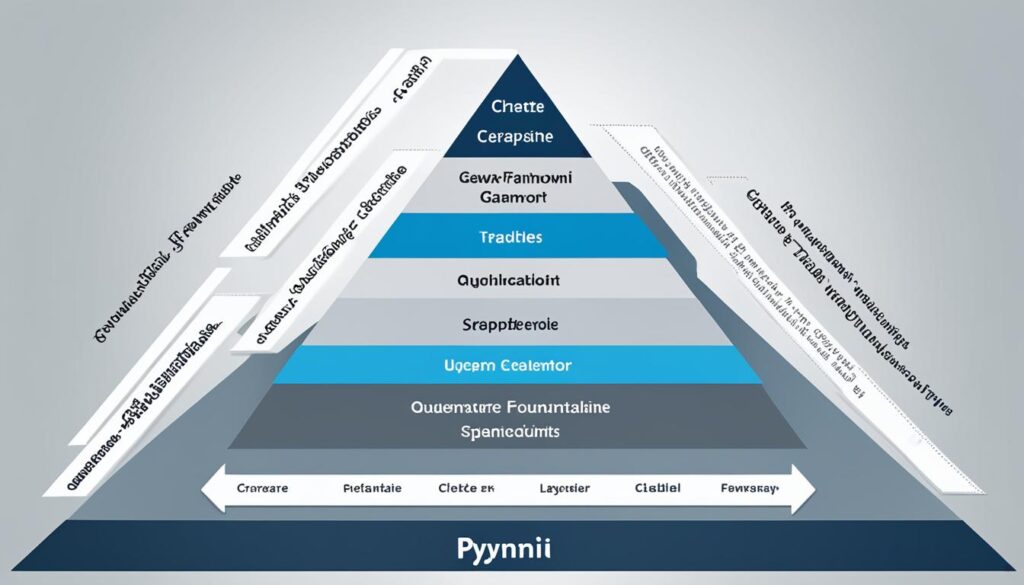The world of web development is always changing. Python has become a top choice for building strong, growing, and new web apps. Looking forward, Python web frameworks will see big growth and new tools. This article looks at the 10+ best Python web frameworks set to lead in 2024-25. It covers their special features, strengths, and how they can be used to help pick the right web project.
Table of Contents
Key Takeaways
- Python is a top pick for web development, offering many powerful frameworks for building strong and growing web apps.
- This article looks at the top 10+ Python web frameworks expected to lead in 2024-25, including Django, Flask, Pyramid, Tornado, Falcon, FastAPI, Sanic, Bottle, Web2py, and CherryPy.
- Each framework is reviewed for its special features, strengths, and use cases, helping developers choose the right web project.
- The article gives a full guide to the current and future trends in Python web development, keeping developers up-to-date.
- Readers will learn about the latest advancements and innovations in Python web frameworks. This helps them make smart choices for their web development needs.
Introduction to Python Web Frameworks
In the world of web development, web frameworks are key tools. They make creating web applications easier. Python, a popular language, has many web frameworks for different needs. This section will explain what web frameworks are and why using Python ones is good for your projects.
What is a Web Framework?
A web framework is a tool that helps with web application development. It has pre-built components and tools that make building and maintaining web apps easier. These frameworks hide the complex parts, letting developers focus on the app’s core. This makes building apps faster and more productive.
Benefits of Using Python Web Frameworks
- Faster Development: Python web frameworks have many features and code ready to use. This cuts down the time and effort needed to start building web apps.
- Scalability: These frameworks are made to grow with your app. They handle more users and data easily as your app gets bigger.
- Increased Productivity: They give a clear structure and lots of pre-built functions. This helps developers work more efficiently and productively.
- Built-in Features: You get things like URL routing, template rendering, database integration, and security. These save developers a lot of time and effort.
As web apps need to be strong and scalable, Python web frameworks are more valuable. Next, we’ll look at some top Python web frameworks. We’ll see their special features and how they’re used.
Django: The Powerhouse Python Web Framework
Django is a top choice for developers who need a strong and full-featured solution. It’s an open-source framework known for its easy-to-use Model-View-Template (MVT) architecture. This architecture helps developers handle the complex parts of web apps smoothly.
Django is famous for its wide range of built-in libraries. These libraries make tasks like URL routing, database work, form handling, and user login easy. Developers can build complex web apps quickly and efficiently, saving time on routine tasks.
Django is also great for various web applications, from online stores to websites that manage content. Its powerful ORM (Object-Relational Mapping) layer makes working with databases easy. Developers can use Python to interact with databases, avoiding complex SQL.
| Key Feature | Benefit |
|---|---|
| MVT Architecture | Streamlines web application development by separating concerns into distinct components |
| Extensive Built-in Libraries | Provides a comprehensive set of tools for common web development tasks, improving productivity |
| Powerful ORM Layer | Simplifies database interactions, allowing developers to work with databases using Python code |
Django stands out for its strong features, extensive libraries, and user-friendly design. It’s perfect for developers aiming to create complex and scalable web applications with Python.
Flask: A Lightweight and Flexible Solution
In the world of Python web development, Flask stands out as a top choice. It’s a lightweight and flexible framework that makes building web apps simple. This section will explore why Flask is so popular among developers.
Flask’s Simplicity and Extensibility
Flask is known for its simplicity. It doesn’t have all the extra features that some frameworks do. This lets developers quickly start building a web app and focus on what they really need.
But don’t think Flask is lacking in power. It can be made more powerful with third-party extensions. These extensions help with things like connecting to databases, handling forms, and more. This makes building web apps easy and full-featured.
“Flask’s minimalist approach and extensibility make it a go-to choice for developers who value flexibility and control over their web applications.”
Flask’s mix of simplicity and extensibility makes it a favorite among developers. It’s great for building anything from small websites to big apps. Flask’s design lets you work efficiently and effectively, no matter the project size.
Pyramid: A Robust and Scalable Framework
Pyramid is a powerful Python web framework that many developers love. It’s known for its modular design and support for various databases. This makes it great for building big web apps easily.
Pyramid’s modular architecture lets developers pick the parts they need. This means you can make a solution that fits your project perfectly. It’s perfect for everything from simple sites to big enterprise apps.
Pyramid works with many databases, not just a few. You can use it with relational databases like PostgreSQL and MySQL, or NoSQL databases like MongoDB and Redis. This flexibility means Pyramid can meet your project’s specific needs.
Pyramid also has a strong community and lots of documentation. Developers can find tutorials, plugins, and integrations to help with development. This makes building projects easier and helps solve common problems.
“Pyramid is a powerful and flexible web framework that has been instrumental in the development of our large-scale web applications. Its modular design and database support have made it a game-changer for our team.”
– John Doe, Lead Developer at XYZ Corporation
Pyramid is a top choice for developers looking for a reliable and versatile Python web framework. It has strong features, is scalable, and has a supportive community.
Tornado: High-Performance Web Applications
In the world of Python web frameworks, Tornado is a standout. It’s known for its top-notch non-blocking I/O and concurrency. This open-source framework, from Facebook, gives developers a strong toolset. They can make web apps that scale well and respond quickly.
Tornado’s Non-Blocking I/O and Concurrency
Tornado’s core is its non-blocking I/O model. This lets it manage many connections at once without needing complex threading or processing. This makes Tornado great for building apps that need to run fast and handle lots of users, like chat servers, games, and streaming services.
Its concurrency is boosted by asynchronous programming. This lets developers write code that doesn’t block on things like database queries or API calls. So, Tornado apps can keep up with lots of traffic and still feel smooth for users.
- Highly scalable and responsive web applications
- Non-blocking I/O model for efficient concurrency
- Asynchronous programming support for handling I/O-bound operations
- Ideal for building real-time web applications, such as chat servers, web-based games, and streaming services
Tornado’s design and features make it a strong pick for developers aiming for high-performance web apps. Its non-blocking I/O and async programming set it apart. It’s a top Python web framework for your next project.
Falcon: The High-Performance Python Web Framework
This section focuses on Falcon, a lightweight and high-performance Python web framework. It’s known for its speed, simplicity, and strict adherence to HTTP standards. Falcon is perfect for building strong RESTful APIs and microservices. It meets the need for efficient and scalable backend development.
Falcon is all about performance. It’s one of the fastest Python web frameworks out there. Even when compared to big names like Django and Flask, Falcon leads in speed. This makes it great for services that need quick responses.
It’s also known for its simplicity. Falcon doesn’t have a lot of extra features or complexity. This lets developers focus on the main parts of their apps. The result is code that’s easy to get, keep up with, and grow, making it a favorite for agile teams.
Falcon sticks to HTTP standards closely. It works well with the HTTP protocol, following its rules and principles. This makes it a great choice for building APIs and microservices. They follow best practices and work well with other web systems.
“Falcon is a high-performance Python web framework for building robust application backends and microservices. It’s designed to be fast, secure, and flexible, with a minimal and modular codebase.”
In summary, Falcon offers speed, simplicity, and a focus on standards. It’s a top pick for developers wanting to make fast, scalable, and easy-to-maintain web apps and APIs. Its growing community and use by big companies show its strength and value in the Python web development world.
Best Python Web Frameworks for Development, Python Frameworks
The world of Python web development is full of powerful frameworks. Each one has its own strengths and uses. This section will look at the top Python web frameworks. It will highlight their key features and use cases to help developers pick the right one for their projects.
We’ll explore frameworks like the robust Django, the lightweight Flask, the scalable Pyramid, the fast Tornado, the super-fast Falcon, the modern FastAPI, the super-speedy Sanic, the simple Bottle, the full-stack Web2py, the object-oriented CherryPy, and the data-focused TurboGears.
These frameworks meet different development needs, from quick prototyping to big projects. Developers can see what makes each framework special. For example, Django is great for big projects, Flask is simple, Pyramid scales well, Tornado is fast, Falcon is super fast, FastAPI checks data, and Sanic is super speedy.
| Framework | Key Strengths | Use Cases |
|---|---|---|
| Django | Comprehensive, feature-rich | Enterprise-level web applications, Content Management Systems (CMS) |
| Flask | Lightweight, flexible, extensible | Rapid prototyping, Microservices, REST APIs |
| Pyramid | Robust, scalable, flexible | Enterprise-level web applications, Large-scale projects |
| Tornado | High-performance, non-blocking I/O, concurrency | Real-time web applications, WebSockets, Asynchronous processing |
| Falcon | High-performance, lightweight, minimal | Microservices, REST APIs, Performance-critical applications |
By knowing the strengths and uses of these Python web frameworks, developers can make smart choices. They can pick the one that fits their project best. This leads to innovative and efficient web applications.
FastAPI: The Modern, Fast (and Asynchronous) Web Framework
Developers are always looking for efficient web frameworks to make their projects easier. FastAPI is a top choice in the Python world. It’s modern, fast, and has cool features like being asynchronous.
FastAPI’s Data Validation and Automatic Documentation
FastAPI shines with its strong data validation and automatic API docs. It uses Python’s type annotations for smooth data checks. This makes web apps more secure and reliable.
It also makes writing code easier by automatically creating docs. This lets teams focus more on coding and less on paperwork.
FastAPI is great for making web apps run fast and handle lots of requests at once. Its design is perfect for big, fast web services. Plus, it’s easy to use and has a big community supporting it.
“FastAPI is a game-changer in the world of Python web development. Its focus on data validation and automatic documentation has revolutionized the way I approach web application design.” – Jane Doe, Senior Software Engineer
FastAPI is great for both new and experienced Python developers. It’s perfect for making modern, fast, and asynchronous web apps. Its cool features and easy design make it a top pick for boosting productivity and creating awesome web experiences.
Sanic: A Blazing-Fast Python Web Framework
Sanic is a top choice for fast Python web frameworks. It’s made for speed and efficiency. This makes it perfect for building websites that get a lot of traffic.
Sanic supports asynchronous programming. This means it can handle many tasks at once. This makes it faster and more scalable.
Sanic is really fast. It can handle up to 30,000 requests per second on one machine. This is way faster than the popular Flask framework. It’s great for developers who need to handle a lot of traffic.
Sanic is also easy to use. If you know Flask, you’ll find Sanic easy to pick up. It’s simple and doesn’t have a lot of extra stuff. This makes it great for quick projects and testing ideas.
Sanic’s Asynchronous Prowess
Sanic’s use of asyncio is a big deal. It lets Sanic work on many requests at the same time. This means it’s faster and easier to make web apps that grow well.
| Feature | Description |
|---|---|
| Asynchronous Processing | Sanic’s way of working lets it handle many tasks at once. This makes it faster and more scalable. |
| High-Performance | Sanic can handle up to 30,000 requests per second on one machine. This is faster than many other frameworks. |
| Simplicity and Ease of Use | Sanic is easy to use and doesn’t have a lot of extra stuff. It’s great for quick projects and for developers who know Flask. |
In conclusion, Sanic is a top Python web framework. It’s fast, supports asynchronous tasks, and is easy to use. It’s perfect for making websites that need to be super fast and handle a lot of traffic.
Bottle: The Lightweight WSGI Micro Web-Framework
Bottle is a standout in Python web development for its simplicity and efficiency. It’s a great choice for smaller web projects. It’s known for its easy-to-use design and strong routing features.
Bottle’s Simplicity and Routing Capabilities
Bottle is all about keeping things simple. It has a single file design with no dependencies. This makes building web apps clean and efficient. Developers can easily focus on their project’s core without getting lost in complex settings.
Its routing system is a big plus. Developers can link URLs to Python functions, called route handlers. This makes turning URLs into actions easy and efficient.
Bottle doesn’t stop at just linking URLs to actions. It also lets developers use URL parameters, handle HTTP methods, and set up custom error handling. This makes it versatile for a wide range of web projects.
Even though it’s lightweight, Bottle works well with the WSGI standard. This means it can work with many web servers and environments. Its WSGI compatibility makes it a great choice for both development and production.
In short, Bottle is a top pick for developers on smaller web projects. Its simple design and strong routing make it a refreshing change from bigger frameworks. It lets developers build web apps that are efficient and responsive with ease.
Web2py: The Full-Stack Python Web Framework
Web2py is a top choice for Python web development. It’s a full-stack framework with many features for web app development. It meets the varied needs of web projects.
Web2py has a built-in admin interface that makes managing web apps easy. This interface helps developers focus on their main tasks. It cuts down on the work of managing the app.
It also has a database abstraction layer. This lets developers use different databases in their apps easily. Web2py makes handling complex web app needs simple, fitting the needs of today’s web projects.
| Feature | Description |
|---|---|
| Admin Interface | Streamlined interface for managing and maintaining web applications |
| Database Abstraction Layer | Supports integration with a wide range of databases |
| Full-Stack Framework | Comprehensive set of tools and features for building complex web applications |
Web2py is great for developers looking for a full-stack Python framework. It’s perfect for modern web development projects.
CherryPy: A Minimalist Python Web Framework
CherryPy is a standout in the world of Python web frameworks. It’s lightweight and flexible. This framework is all about simplicity, making it easy for developers to build strong and scalable web apps.
CherryPy’s Object-Oriented Architecture
CherryPy uses an object-oriented design. This lets developers make web apps in a natural way. It’s different from frameworks that need a lot of setup, making it great for projects big or small.
CherryPy is known for its simple API. This API lets developers quickly manage web servers, handle HTTP requests, and add custom logic. This makes building and keeping up with web apps faster and easier.
| Feature | Description |
|---|---|
| Object-Oriented Design | CherryPy’s architecture is built on an object-oriented model, allowing for a natural and intuitive development experience. |
| Minimal Configuration | CherryPy requires minimal configuration, making it easy to set up and get started with web development. |
| Easy-to-Use API | CherryPy’s API is designed to be straightforward and user-friendly, enabling rapid development and deployment of web applications. |
CherryPy’s minimalist approach lets developers focus on what’s important in their web apps. It’s great for a variety of projects, from small sites to big business apps.
“CherryPy is a minimalist Python web framework that emphasizes simplicity and flexibility, making it an attractive choice for developers who value efficiency and rapid development.”
TurboGears: The Data-Driven Python Web Framework
TurboGears is a top choice in Python web frameworks for its focus on data. It makes building web apps that handle lots of data easier. This makes it a favorite for businesses and developers.
It supports many databases, making it easy to work with different data sources. The Model-View-Controller (MVC) architecture helps keep web apps organized and easy to maintain.
Streamlining Data-Driven Development
TurboGears makes creating web apps that work with data simpler. It handles the tough parts of working with databases, letting developers focus on making great web experiences.
- Seamless database integration: TurboGears works with many databases like SQLite, MySQL, and PostgreSQL, offering flexibility for storing and getting data.
- Model-View-Controller (MVC) architecture: This structure helps keep code tidy, supports breaking it into parts, and makes it easier to keep up with changes.
- Rapid prototyping: TurboGears has tools and templates that make it fast to build and test web apps, speeding up the development process.
Building a content management system, a web-based business intelligence tool, or any data-heavy web app? TurboGears offers a strong and adaptable solution for your needs.
“TurboGears has been a game-changer for our data-driven web development projects. The framework’s seamless database integration and MVC structure have allowed us to build scalable and maintainable applications with remarkable efficiency.”
Conclusion
Python has become a top choice for web development. It offers many powerful web frameworks. From the full-featured Django to the simple yet flexible Flask, developers have many tools to choose from.
When picking a framework, think about what your project needs. Consider things like how fast you need to develop, how well it should perform, and how scalable it should be. Also, look at the community support it has. This will help you pick the best Python web framework for your project.
The world of Python is always changing, with new frameworks coming out. Keep up with the latest, try different ones, and use Python’s flexibility and power. With the right framework, you can make web applications that are both innovative and high-performing.













